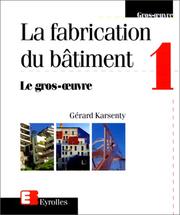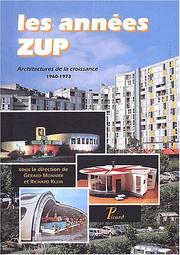| Listing 1 - 10 of 14 | << page >> |
Sort by
|
Book
ISBN: 2852063689 2852063298 2852063301 Year: 1986 Publisher: Paris
Abstract | Keywords | Export | Availability | Bookmark
 Loading...
Loading...Choose an application
- Reference Manager
- EndNote
- RefWorks (Direct export to RefWorks)
Technoloby, Pharmaceutical --- Medical Laboratory Science --- Drug Packaging --- Pharmacotechnology. Preparations --- Surgery --- Matiere plastique
Book

ISBN: 2858504997 9782858504992 Year: 1989 Publisher: Paris : Centre Georges Pompidou,
Abstract | Keywords | Export | Availability | Bookmark
 Loading...
Loading...Choose an application
- Reference Manager
- EndNote
- RefWorks (Direct export to RefWorks)
La matière n'a jamais tant fait bouger la pensée. Plastiques, métaux, céramiques et composites accroissent et diversifient leurs performances, échangent leur technologie et leurs domaines d'application, l'auteur examine comment ces matériaux modifient le processus même de conception d'un produit et les qualités techniques, mais aussi culturelles, qu'on peut attendre d'un objet.
Industrial design --- Design --- Materials --- Matériaux --- Materiaux. --- Transparence --- Matière plastique --- Produits nouveaux --- Design industriel --- Philosophie --- Innovations --- Matériaux --- Produits nouveaux. --- Design industriel. --- Philosophie. --- Innovations.
Book
ISBN: 9782100563531 210056353X Year: 2013 Publisher: Paris : Dunod,
Abstract | Keywords | Export | Availability | Bookmark
 Loading...
Loading...Choose an application
- Reference Manager
- EndNote
- RefWorks (Direct export to RefWorks)
"Le choix et la mise en oeuvre des matériaux de construction ont toujours été guidés par des critères techniques et architecturaux. À ces derniers s'ajoutent aujourd'hui des critères environnementaux afin d'ancrer la démarche architecturale dans le cadre du développement durable. Cet ouvrage présente les principaux matériaux de l'architecture : le bois et les matériaux de la biomasse, l'acier, les bétons et les liants hydrauliques, les roches naturelles, le verre et les polymères. Chacun d'eux fait l'objet d'une description détaillée (contexte historique de leur utilisation, composition et procédés de transformation, propriétés architecturales, constructives et physiques) et d'un bilan environnemental (impact énergétique de leur fabrication, territoires de production et transport, mise en oeuvre sur le chantier, entretien et fin de vie). Richement illustré, cet ouvrage constitue un guide de référence et un indispensable outil de conception à destination des architectes, mais également des bureaux d'étude, des maîtres d'ouvrages, des artisans et des étudiants en architecture." [4e de couverture]
Building materials --- Sustainable architecture --- Construction --- Architecture durable --- Matériaux --- Construction écologique --- Matériau --- Bois --- Bambou --- Matériau végétal --- Acier --- Béton --- Chaux --- Plâtre --- Pierre --- Construction en terre --- Verre --- Matière plastique --- Matériaux --- Constructions --- Environmental aspects --- Aspect environnemental.
Book
ISBN: 9782880747220 2880747228 Year: 2007 Publisher: Lausanne : Presses polytechniques et universitaires romandes,
Abstract | Keywords | Export | Availability | Bookmark
 Loading...
Loading...Choose an application
- Reference Manager
- EndNote
- RefWorks (Direct export to RefWorks)
Facades --- Façades --- Construction --- Envelloppe architecturale --- Façade --- Façade légère --- Façade-panneau --- Façade-rideau --- Conception et construction --- Dessins et plans --- Façades --- Assemblage --- Béton --- Bois --- Brique --- Détail de construction --- Matière plastique --- Métal --- Mur --- Pierre --- Structure --- Verre --- Conception et construction. --- Dessins et plans.
Periodical
ISSN: 18737048 13645439 Year: 1996 Publisher: Cambridge : [Oxford?] : Royal Society of Chemistry, Elsevier Advanced Technology
Abstract | Keywords | Export | Availability | Bookmark
 Loading...
Loading...Choose an application
- Reference Manager
- EndNote
- RefWorks (Direct export to RefWorks)
Powder coatings --- Periodicals --- Protective coatings industry --- Plastic powders --- Plastic coatings --- Plastic coatings. --- Plastic powders. --- Protective coatings industry. --- Revêtement en poudre. --- Matière plastique. --- Revêtement protecteur. --- Powdered plastics --- Coatings --- Protective coatings --- Coatings industry --- Powders
Book
ISBN: 285893732X 9782858937325 Year: 2004 Publisher: Paris : J.M. Place : Jousse entreprise,
Abstract | Keywords | Export | Availability | Bookmark
 Loading...
Loading...Choose an application
- Reference Manager
- EndNote
- RefWorks (Direct export to RefWorks)
La Bulle six coques, conçue dans les années 1960 par l'architecte et urbaniste Jean Benjamin Maneval, est un projet singulier d'habitat en plastique produit en série. Il associe de manière exemplaire recherche d'avant-garde, ingénierie et collaboration avec la grande industrie. Les prototypes ainsi que les documents destinés à la commercialisation de la Bulle sont les parfaites expressions de l'esthétique des années « pop ». Le village de vacances de Gripp, qui regroupe une vingtaine de Bulles et restera en service jusqu'en 1998, est le témoignage d'un ensemble unique au monde. (Quatrième de couverture)
Buildings, Plastic --- Vacation homes --- Buildings, Portable --- Visionary architecture --- Constructions en plastique --- Chalets --- Constructions transportables --- Architecture visionnaire --- Maneval, Jean Benjamin, --- Coque --- Industrialisation de la construction --- Matière plastique --- Préfabrication --- Village de vacances --- Construction expérimentale --- Construction modulaire --- Habitat vacancier --- Maneval, Jean Benjamin --- Criticism and interpretation --- Buildings, Plastic - France --- Vacation homes - France --- Visionary architecture - France --- Maneval, Jean Benjamin, - 1923-1986 - Criticism and interpretation --- Maneval, Jean Benjamin, - 1923-1986

ISBN: 2212018967 2212018975 9782212018967 9782212018974 Year: 1997 Publisher: Paris : Eyrolles,
Abstract | Keywords | Export | Availability | Bookmark
 Loading...
Loading...Choose an application
- Reference Manager
- EndNote
- RefWorks (Direct export to RefWorks)
Construction. --- Construction, Technique de la. --- Béton --- Béton armé --- Béton précontraint --- Bois --- Charpente métallique --- Construction --- Construction en bois --- Fondations --- Géotechnique --- Gros oeuvre --- Maçonnerie --- Matériau --- Mécanique des sols --- Technologie --- Technologie de la construction --- Aluminium --- Cloison --- Couverture --- Escalier --- Façade --- Matériau de remplissage --- Menuiserie --- Pathologie --- Pathologie de la construction --- Plancher --- Matière plastique --- Plâtre --- Procédé de construction

ISBN: 2708406299 9782708406292 Year: 2002 Publisher: Paris Picard
Abstract | Keywords | Export | Availability | Bookmark
 Loading...
Loading...Choose an application
- Reference Manager
- EndNote
- RefWorks (Direct export to RefWorks)
Architecture --- City planning --- Architecture, Industrial --- Cities and towns --- City planning districts --- Urbanisme --- Architecture industrielle --- Villes --- Zones d'aménagement --- History --- Growth. --- Histoire --- Croissance --- Aluminium --- Architecture contemporaine --- Banlieue --- Construction --- Industrialisation --- Piscine --- Plastique --- Growth --- Zones d'aménagement --- Urban architecture --- 1960 --- -Urban architecture --- -City planning --- Matière plastique --- -Architecture --- -City planning - France - History - 20th century --- Cities and towns - France - Growth --- Architecture - France - 20th century --- Architecture, Industrial - France --- City planning - France - History - 20th century
Book
ISBN: 9781856696708 1856696707 Year: 2010 Publisher: London : Laurence King,
Abstract | Keywords | Export | Availability | Bookmark
 Loading...
Loading...Choose an application
- Reference Manager
- EndNote
- RefWorks (Direct export to RefWorks)
Synopsis The physical scale model is often cited as an important tool of communication for architecture students and practitioners alike. Although the proliferation of CAD programmes has enabled the creation of increasingly complex computer models and virtual environments, there is also a growing need to address the three-dimensional qualities of architecture that may be lost when using such media. This book focuses on the inspiring possibilities for modelling the built environment with all the different media and techniques that are now available. Through description of the use of different models in different contexts, the book provides a practical and effective guide to how and why models are used, in addition to what they are used for, and, furthermore, how they relate to architecture education. Following a brief introduction, the book is divided into three sections: Media, Types and Applications. The book is generously illustrated with photographs of models, accompanying commentaries, and step-by-step practical instructions on the various techniques associated with modelmaking. "Architectural Modelmaking" will provide a concise yet broad 'toolbox' for students of architecture. http://www.waterstones.com/waterstonesweb/products/nick+dunn/architectural+modelmaking/7619695/ (7/12/10)
Architectural models. --- Architectural models --- Modèles architecturaux --- Design and construction --- Conception et construction --- Maquette --- Modélisation --- Processus de conception --- Technique de représentation --- Acier --- Bois --- Carton --- Conception de projet --- Image virtuelle --- Papier --- Photographie --- Plastique --- Résine --- 72.012 --- Architectuur. Bouwkunst--?.012 --- 72.012 Architectuur. Bouwkunst--?.012 --- Modèles architecturaux --- 72.011 --- Architectuurontwerpen ; maquettes ; technieken --- Architectuur ; vormgeving, ontwerp, compositie --- Image de synthèse --- Design and construction. --- Matière plastique --- Conception assistée par ordinateur --- Maquettes (architecture) --- Modélisation tridimensionnelle
Book
ISBN: 1856694801 9781856694803 Year: 2006 Publisher: London Laurence King
Abstract | Keywords | Export | Availability | Bookmark
 Loading...
Loading...Choose an application
- Reference Manager
- EndNote
- RefWorks (Direct export to RefWorks)
In architectural education, the study of materials and the study of design are often treated as separate areas of discourse, when in reality the two are utterly intertwined. The choice of construction materials affects the look and feel of built form, while inspired design sense injects life into a building's ingredients. This book is aimed at students of architecture and young practising architects. Through its detailed descriptions of glass, concrete, wood, metals and plastics - covering their unique properties, histories and various forms - the book lays the educational foundation for any aspiring architect. Each section features 10-12 case studies, including plans, sections, elevations and details, together with colour photographs illustrating the inspired and widely varied ways in which these materials can be applied. Among the case studies are works by Steven Holl, Shigeru Ban, Rural Studio, Campo Baeza, Arets and many others.
Building materials. Building technology --- building materials --- Architecture --- Building materials. --- Architectural design. --- Architecture, Modern --- Construction --- Design architectural --- Case studies. --- Matériaux --- Cas, Etudes de --- Construction en béton --- Construction en bois --- Construction en verre --- Construction métallique --- Dessin technique --- Elément d'architecture --- Détail de construction --- Matière --- Matière plastique --- 691 --- Architectuur ; materialen --- Bouwmaterialen ; constructies ; handboeken --- Wanden ; muren ; vloeren ; plafonds ; daken ; gevels --- 692.232 --- 69.06 --- Design --- Structural design --- Architectural materials --- Building --- Building supplies --- Buildings --- Construction materials --- Structural materials --- Materials --- Bouwmaterialen (architectuur) --- Constructie-elementen van gebouwen ; buitenmuren ; bekleding --- Bouwwezen ; draagconstructies, pneumatische constructies, overspanningen --- History --- Architectuur --- Materiaalleer --- Architectuur. --- Design. --- Materiaalleer. --- Matériaux --- Building materials --- Architectural design
| Listing 1 - 10 of 14 | << page >> |
Sort by
|

 Search
Search Feedback
Feedback About UniCat
About UniCat  Help
Help News
News